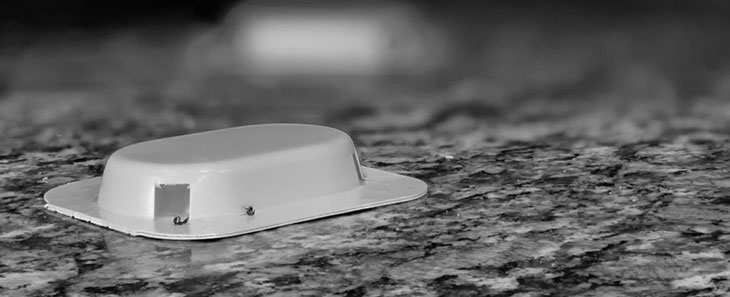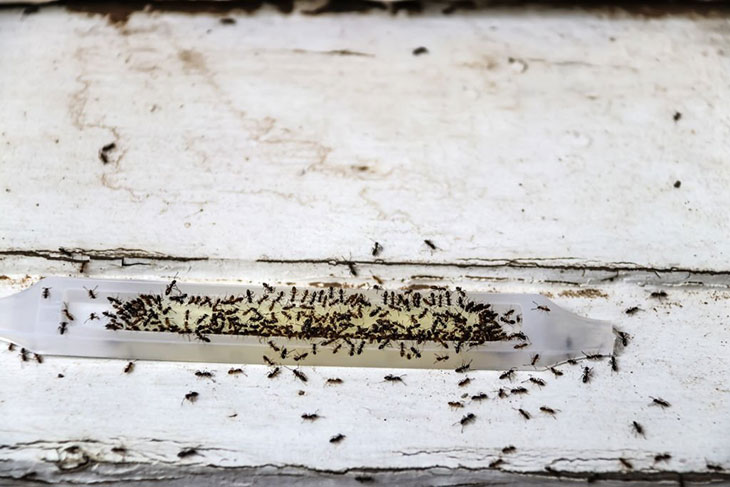For dog owners, when faced with the annoying problem of an ant infestation in their house, the thought of using ant bait often comes to mind.
However, the question arises: “Are ant traps safe for dogs?”
In this section, I will examine ant traps and their impact on dogs, providing valuable knowledge and guidelines for taking care of your pets.
With our preventive measures, you can create a secure environment for your puppies while effectively handling ant invasions.
Are Ant Traps Safe For Dogs?

No, the plastic construction of ant traps, as well as the toxic substances present in them, pose potential health risks to your pets.
What Are Ant Traps?
Ant traps are devices designed to attract and eliminate ants. They usually contain bait poison infused with insecticides that are enticing to ants.
The goal is to lure ants to the bait, where they will consume the poison and transport it back to the colony, eradicating the ant population over time.
They are effective for ant control, but if not handled carefully, they can be hazardous to our canine companions.
Why Are Ant Traps Concerning For Dogs?
Ant traps are concerning for canines not only because of the toxic compounds they contain and their plastic material but also due to the puppy’s instinctive behaviors.
Naturally curious dogs may be attracted to the smell of peanut butter on the ant bait.
They may perceive the ant trap as a toy, engage in playful interactions, or even attempt to chew on it.
However, ingesting the bait or contacting trapped ants can lead to various health issues for our beloved pets.
Potential Dangers Of Ant Traps For Dogs
Toxic Ingredients In Ant Traps
The bait used in ant traps often contains harmful chemicals and compounds that can be poisonous to dogs when ingested or absorbed through the skin, such as organophosphates and pyrethroids.
In addition to the poisons they contain, plastic ant catchers can be hazardous to your puppy.
When canines chew on these plastic ant catches, they can shatter them into sharp pieces.
These fragments can then travel through the digestive system and cause blockage or perforations in the stomach.
Symptoms Of Ant Trap Poisoning In Dogs
When a dog comes into touch with the dangerous compounds found in ant killers, it might develop a variety of poisoning symptoms.
These substances can disrupt their digestive system, leading to gastrointestinal distress, such as abdominal pain, vomiting, and diarrhea.
The toxic compounds can also affect the nervous system, resulting in manifestations like tremors, weakness, and lack of coordination.
In more severe cases, dogs may accidentally ingest or inhale the insecticides, leading to more serious symptoms such as excessive drooling, respiratory distress, bloody stool, and seizures.
Tips For Using Ant Traps Safely Around Dogs

Choose Safe Ant Traps For Dogs
When selecting an ant killer, look for products specifically labeled as ant traps safe for pets, including dogs.
Advion Ant Gel and Terro Liquid Ant Bait are two famous brands that you can rely on.
These traps are designed with pet-friendly bait or active ingredients that have lower toxicity levels.
By choosing these safer options, you can minimize the risk of exposing your dog to harmful substances.
Placement Of Ant Traps
Proper placement of ant bait stations in your house is essential to keep your dog safe. It would be best if you put the traps in areas that are inaccessible to your dog.
For example, you can place them in high locations, behind closed doors, or inside kitchen cabinets where your dog cannot reach or knock them over.
Furthermore, It’s not a good idea to use ant killer around pets’ food and water area or on the ground where they frequently roam.
Monitor And Secure The Area
Use ant traps only when you are at home, as this will enable you to monitor the zone where the traps are placed regularly.
By being present, you can keep a close watch on your dog’s activities and prevent them from coming into contact with the toxicants.
When you have a curious or determined pet, consider using barriers or baby gates to restrict their access to areas with ant killer.
Additionally, if you notice your puppy showing curiosity or attempting to access the traps, take immediate action to remove them from their old position and secure them in a safer location.
FAQs

What Should I Do If My Dog Shows Signs Of Ant Trap Poisoning?
If you suspect your dog has been exposed to or ingested an ant trap and shows signs of poisoning, it is crucial to seek immediate veterinary attention.
At that moment, time is gold, so you have to contact the veterinarian or an emergency veterinary clinic right away.
However, do not panic and be prepared to provide information about the specific product and the amount your puppy may have been exposed to.
Veterinary bills can be quite expensive, so having pet insurance for canines can help you reduce the costs significantly when unfortunate situations arise.
What Steps Can I Take To Prevent Ants Without Using Traps?
There are some safe ant control methods without using traps that you can use:
First, keep your home clean. You should regularly clean up food spills and crumbs and store food in airtight containers.
Next, seal entry points. Close off any openings or cracks where ants can enter your home is another good way.
You can use caulk or weatherstripping to seal gaps in windows, doors, and other entry points.
Then, maintain a tidy yard.
Ant colonies often form outside the house, so it is necessary to trim vegetation away from your house’s foundation, remove debris, and keep outdoor garbage cans sealed.
Finally, use natural repellents. Some people like using natural ant repellents such as vinegar, lemon juice, cinnamon, peppermint oil, or Diatomaceous Earth powder.
These substances can help deter ants without posing risks to your canines.
What Other Types Of Baits Can Be Toxic To Dogs?
While ant traps are a common concern, it’s important to be aware that other types of bait can also be poisonous to dogs.
Rodenticides, slug and snail baits, and certain insect baits may contain substances that are harmful to puppies if ingested.
It’s essential to keep these products securely stored in areas inaccessible to your canines and to use pet-safe alternatives whenever possible.
Remember that the well-being and safety of your pet should always be a top priority.
If you have any concerns or questions regarding ant killer or other potential hazards, consult with a veterinarian who can provide specific advice tailored to your furbaby’s needs.
Conclusion
We have found the answer to the question, “Are ant traps safe for dogs?”.
While ant traps can be effective in controlling ant infestations, they can pose potential risks to your beloved canine companion due to the presence of toxic substances.
It is advisable to opt for pet-safe ant killer options, carefully position them in secure areas, closely monitor your dogs’ interactions with the traps, and promptly consult with a veterinarian if any concerns arise.
Following these guidelines, you can establish a safe environment and proactively prevent your cherished pets from any potential risks or exposure to harmful substances found in ant bait.
